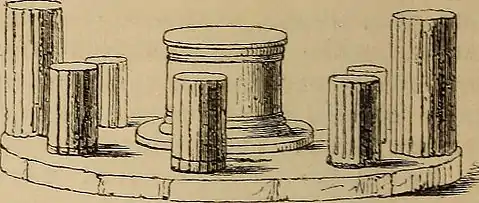Bidental
In ancient Roman religion, a Bidental was a sacred spot erected on the location where lightning had struck. Any remains and scorched earth were to be burned in a hole at the location by priests called bidentales. Any person killed was to be buried in the earth where the lightning hit, as opposed to traditional cremation. A puteal (wellhead), or sometimes more than one, was then placed on the spot of burned earth. In order to further consecrate the spot, the head officiator would sacrifice a two-year-old sheep (called bidens). Finally, an altar was built, surrounded by a wall or fence to keep any trespassers away. Considered sacred, it was not to be touched, tread on, or even looked at after completion. Occasionally when falling into a state of decay, Bidentals would be repaired or reconstructed.
_01.jpg.webp)
Places being struck by lightning were regarded as a terrifying example of godly wrath, and not to be taken lightly. Had any person committed sacrilege, they were punished severely with frenzy. Primarily it was believed that these shows of divine power were displayed specifically by Jupiter, King of the gods.

References
- "The Divine Thunderbolt." Google Books. Web. 21 Nov. 2015.
- "Gentleman's Magazine, and Historical Chronicle." Google Books. Web. 17 Nov. 2015.
- "P996 Bidental." LacusCurtius • Roman Religion. Web. 23 Oct. 2015.
- "The Illustrated Companion to the Latin Dictionary and Greek Lexicon." Internet Archive. 1849. Web. 11 Nov. 2015.
